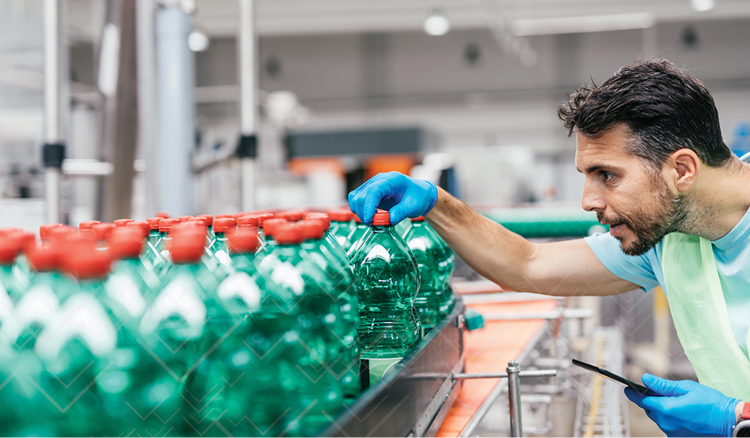How Veryable Addresses The Top 5 Challenges Highlighted in the NAM's Q2 2025 Survey
The National Association of Manufacturers (NAM) Quarterly Manufacturers’ Outlook Survey is a widely respected industry benchmark that gauges the sentiments of manufacturers across the United States. Conducted every quarter, the survey collects responses from leaders in manufacturing to track their business outlook, identify top operational and economic challenges, and forecast trends related to production, workforce, capital spending, and market conditions.
The recent Q2 2025 survey reveals a notable shift in sentiment within the sector, with only 55.4% of manufacturers expressing a positive outlook for their companies—a sharp decline of nearly 15% from the previous quarter. This drop marks the lowest confidence level since the height of the COVID-19 pandemic in Q2 2020, a period marked by severe supply chain disruptions, workforce challenges, and economic uncertainty.
In this article, we’ll explore the top five challenges highlighted in the survey, and examine how companies can effectively address them with Veryable’s on-demand labor model.

Challenge #1: Trade Uncertainties
In the Q2 2025 survey, trade uncertainties once again emerged as the most pressing concern for manufacturers, with 77.0% of respondents identifying it as a top business challenge—for the second consecutive quarter. This number highlights how manufacturers continue to grapple with a volatile mix of tariff fluctuations, shifting trade policies, and global supply chain disruptions. These factors have significantly undermined business confidence and complicated strategic planning, forcing companies to constantly adapt to changing conditions.
How Veryable Helps
Veryable’s on-demand labor model provides companies with a flexible approach that directly addresses the unpredictability caused by trade uncertainties. By allowing manufacturers and logistics operations to tap into a pool of skilled, vetted workers on an as-needed basis, Veryable helps them quickly scale their labor capacity up or down without the long-term commitments, costs, or risks of traditional approaches. This agility enables companies to adapt to sudden changes in order volumes, material shortages, or market shifts without compromising quality.
In an environment where trade policies and global supply chain dynamics can change in the blink of an eye, Veryable’s approach empowers companies to manage risk more effectively. Instead of being tied to a fixed workforce that might become underutilized during downturns or overwhelmed during surges, companies can match labor to demand in real-time. This means they can maintain service levels and delight customers even amid external shocks. Ultimately, Veryable’s on-demand labor model acts as a buffer against volatility, giving companies the confidence to navigate trade-related uncertainties with greater operational resilience.
Challenge #2: Rising Raw Material Costs
Raw material price inflation has surged to its highest level since mid‑2022, with 66.1% of respondents citing it as a top challenge. Commodity prices—covering metals, plastics, lumber, and chemicals—have seen notable volatility. According to the Q2 2025 survey, manufacturers expect these input prices to rise by an average of 5.8% over the next year, marking the fastest anticipated growth since Q2 2022. Many companies are grappling with the ripple effects of trade tariffs, shipping bottlenecks, and tightening supply chains, which are all pushing material prices higher. As a result, materials now represent a swiftly rising share of production costs, compressing profit margins and complicating forecasting.
This materials cost challenge follows industry-wide concern over trade uncertainties—cited by 77.0% of respondents—and is closely linked to the tariff-related pressure, with 89.0% of manufacturers reporting increased costs due to new tariffs in 2025. With many operations running on thin margins, such sustained input price increases force manufacturers to make difficult decisions: raising product prices (Q2 2025 saw a projected 4.3% hike in prices), cutting investments, or reconsidering hiring plans.
How Veryable Helps
Veryable’s on-demand labor model helps companies counter the impact of rising material costs by enabling them to operate in a more cost-efficient manner. With fluctuating material prices putting pressure on margins, companies can no longer afford to maintain an oversized permanent workforce. Veryable’s on-demand labor model allows companies to maintain a leaner full-time headcount and then scale each day to the precise level of support required. This eliminates labor waste and frees up resources to absorb higher material costs. For example, one of our users, Scentsational Soaps & Candles, was able to reduce labor costs by 15% over the course of a few months.
Additionally, by providing rapid access to skilled operators on an as-needed basis, Veryable empowers companies to complete projects and fulfill orders more quickly, minimizing the risk of inventory holding costs or spoilage as material prices fluctuate. Faster production cycles mean materials are converted to finished goods sooner, reducing exposure to future price spikes. In this way, Veryable’s model supports a more responsive, agile operation, allowing companies to offset changing material costs while maintaining world-class quality and service.
Challenge #3: Rising Healthcare and Insurance Costs
Healthcare and insurance premiums have been climbing steadily for years, but manufacturers feel these pressures especially acutely because they traditionally offer comprehensive benefits to attract and retain skilled workers. In the Q2 2025 survey, 60% of respondents flagged healthcare and insurance costs as a top challenge. With premiums, deductibles, and other healthcare-related expenses outpacing inflation, manufacturers face tightening profit margins while trying to maintain competitive benefits packages. Many midsize and smaller manufacturers are particularly vulnerable, as they have less negotiating leverage with insurers than large corporations, making it harder to control year-over-year premium increases.
Additionally, manufacturers often operate on slim margins and must compete for talent in a tight labor market, which pressures them to keep benefits robust despite cost spikes. Rising healthcare costs don’t just impact the bottom line — they also affect employee morale and retention if companies are forced to pass higher costs onto workers or reduce coverage.
How Veryable Helps
Veryable’s on-demand labor model helps companies manage rising healthcare and insurance costs by reducing their reliance on full-time workers, which traditionally come with significant benefits and expenses. By supplementing their core workforce with on-demand operators who are 1099 contractors rather than full-time employees, companies can scale their labor capacity without taking on additional healthcare and insurance obligations. This approach allows them to preserve critical benefits for their core team while avoiding the financial strain of providing those benefits to an oversized workforce that may not even be needed year-round.
At the same time, Veryable’s model provides a sustainable way to meet demand without compromising the stability of existing employees’ benefits packages. Companies can better protect their budgets and shield themselves from volatile increases in premiums and healthcare costs by only committing benefits to a leaner, permanent headcount. The flexible, on-demand approach ensures they remain competitive and responsive while keeping fixed labor-related costs, like insurance, to a minimum. This financial breathing room also helps companies focus resources where they matter most, fostering long-term growth and stability.
Challenge #4: Weaker Domestic Economy and Sales to U.S
56.3% of respondents in this latest survey identified a weaker domestic economy and declining sales to U.S. customers as a top business challenge.
This concern reflects a significant downturn in manufacturing sentiment, with overall optimism dropping to 55.4%, down from 69.7% in the previous quarter. Manufacturers are grappling with reduced consumer demand, tighter credit conditions, and a cautious business environment, leading to expectations of only a 1.3% increase in sales over the next 12 months, compared to 3.4% in Q1.
The combination of weaker domestic demand and economic uncertainty is prompting manufacturers to reassess investment plans, hiring strategies, and pricing models.
How Veryable Helps
Veryable’s on-demand labor model empowers companies to build down-cycle agility and quickly adapt to slower sales. Rather than maintaining a fixed headcount that might not be needed every day or dealing with costly layoffs, companies with a Veryable workforce in place can instantly scale their labor capacity down to ensure labor costs are aligned precisely with demand. This agility helps preserve cash flow, minimize overhead, and maintain productivity without the burden of carrying underutilized full-time staff through a downturn. A few years ago during the UAW strike, this approach helped ADAC achieve $1.6M in cost avoidance.
Additionally, Veryable gives companies a strategic advantage by enabling them to transition portions of their traditional full-time workforce to on-demand roles, maintaining access to the same skilled talent without long-term employment costs or underutilization. This shift supports a leaner, more efficient operation while protecting critical resources for investment elsewhere during periods of weak sales. As the market begins to recover, Veryable users can also respond faster to growth opportunities and secure a first-mover advantage by quickly deploying their trusted pool of skilled operators.
Ultimately, Veryable’s flexible labor model helps companies maintain stability through economic headwinds while positioning themselves for accelerated growth once demand returns.
Challenge #5: Attracting and Retaining A Quality Workforce
While the challenge of finding and retaining skilled labor certainly isn’t new, it’s also intensifying as more and more companies attempt to shift production back to the United States. In the latest survey, 47.5% of manufacturers cite this as a top concern. This concern underscores the ongoing labor shortages faced by manufacturers, exacerbated by factors such as the retirement of Baby Boomers, and a generational shift in career preferences.
The manufacturing sector is also experiencing growing demand for skilled labor, with projections indicating a need to fill millions of roles over the next decade. But despite the industry's efforts to modernize and offer competitive wages, attracting younger workers remains a challenge due to perceptions of manufacturing jobs as outdated or lacking in work-life balance.
How Veryable Helps
The real issue here isn't a labor shortage. Rather, it's a mismatch between what companies have been offering and what workers are seeking. Veryable’s on-demand labor model helps companies attract a high-quality workforce by providing a flexible, modern work experience that aligns directly with the preferences of today’s workers. Through the Veryable platform, workers gain the freedom to choose when and where they work, fostering greater skills development. This level of autonomy resonates with today’s workforce, who increasingly value flexibility, work-life balance, and opportunities to build diverse skill sets over rigid, traditional employment structures. This is why millions of Americans have signed up to work through Veryable.
Additionally, this approach can significantly improve full-time employee (FTE) morale by eliminating the stress and burnout that arises when core teams are stretched too thin. By supplementing FTEs with on-demand operators during peak periods or unexpected surges, companies can protect their full-time staff from excessive overtime, fatigue, and unsustainable workloads. This helps these employees feel supported, valued, and less overwhelmed, promoting a healthier work environment and reducing turnover while ensuring consistent world class service.
Moreover, Veryable’s model boosts FTE engagement by enabling them to focus on higher-value, strategic tasks rather than being pulled into constant firefighting or repetitive overflow work. On-demand operators can fill routine or non-value-add roles, freeing full-time employees to concentrate on continuous improvement, training, or growth initiatives. This creates a stronger sense of purpose and growth for FTEs, making their jobs more meaningful and engaging.
The Big Picture
In today’s rapidly changing landscape, challenges such as trade uncertainties, rising material and healthcare costs, persistent labor shortages, and a weaker domestic economy are putting tremendous pressure on manufacturers and distributors to remain agile and efficient. Veryable’s on-demand labor model delivers a flexible, scalable solution that gives companies quick access to skilled workers without the long-term commitments, fixed costs, or risks of traditional approaches. This agility helps them control labor expenses, maintain world-class service regardless of demand, and respond immediately to shifting market conditions and external disruptions.
To learn more about the Veryable solution, visit our “for businesses page”. If you’re looking for information tailored to your specific role, click here.
Additional Resources
U.S. Manufacturing Today Podcast
For more information and insights, make sure to check out our new U.S. Manufacturing Today Podcast. Hosted by our Head of Reindustrialization, Matt Horine, and featuring interviews with business leaders as well as industry experts, this podcast covers the latest trends and shifts affecting the U.S. manufacturing and distribution sectors.
In this week’s episode, Merrin Muxlow, Principal at S Industrial and member of the Investment Casting Institute discusses the critical importance of investment casting in manufacturing, emphasizing the need for reshoring, workforce development, and technological innovation to strengthen U.S. industrial independence. She also highlights the role of trade associations and early talent engagement in ensuring long-term industry success.
You can find this podcast on our website, Spotify, Apple, YouTube, and PocketCasts.
Navigating Trump 2.0
For additional insights into the developments under Trump 2.0, visit our “Navigating Trump 2.0” page. There you'll find comprehensive information on recent and potential future changes, along with more articles like this one.
Veryable Vendor Network
The Veryable Vendor Network (VVN) is an ecosystem of manufacturing, warehousing, and logistics companies that utilize Veryable to deliver quality products and world-class service to their customers regardless of demand. If you’re looking for new domestic suppliers, submit a form and our team will be in contact shortly after.
Previous Posts
How On Demand Labor Helps Manufacturers Maintain World Class Quality When Demand Refuses to Sit Still
The Future of Manufacturing and Logistics
Create a free business profile today to explore our platform.






